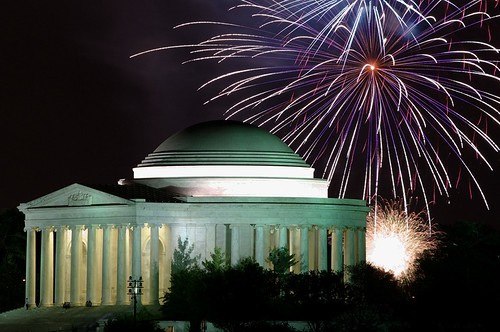
‘DSC_0500’
courtesy of ‘Warren In the Weeds’
This morning marks the 71st anniversary of the laying of the cornerstone of my favorite DC memorial, the Jefferson Memorial on the south side of the Tidal Basin. The Memorial was designed by architect John Russell Pope in 1935, and was one of four that Pope designed, depending on the location that was finally chosen for the monument. The other three sites that weren’t chosen were along the Anacostia River near where RFK sits today, at Lincoln Park, and one across from the National Archives, which Pope also designed.
The Memorial’s architectural features are, itself, a tribute to Jefferson’s style: Ionic columns, a flat dome, a Roman-style Portico, all things that are present at Jefferson’s university in Charlottesville, the University of Virginia.

‘Southern View of the District of Columbia from the Washington Monument’
courtesy of ‘Cornell University Library’
The Memorial was, itself, a controversial project. Pope had lost the 1911 competition for the Lincoln Memorial, and was seen by many, despite his design of a number of prominent Washington buildings, as a bit of a show-off, and that wasn’t what they were looking for in the Memorial. His initial Pantheon proposal was 21 feet taller than the Lincoln Memorial, and was tabled by the commission.
In 1937, Pope succumbed to cancer, and his plan was shelved briefly. The Memorial Commission planned a smaller scale version of the Theodore Roosevelt Memorial that he had submitted in the 1920s, but Pope’s widow blocked that construction. Instead, they would build a smaller version of the massive Pantheon, over the protestations of the Commission on Fine Arts, which lobbied hard to prevent the memorial from being built, including a pamphleting campaign (think of this as early “blogger outreach”.)

‘Jefferson Memorial’
courtesy of ‘Chromojenic’
The supporters of the third president’s memorial were a tenacious group with significant backing in the Congress, and the memorial was built over the objections of these groups, who were concerned over denuding the tidal basin (hey, doesn’t that sound familiar?) and that the Beaux-Arts style that Pope favored was too grand for an agrarian president like Jefferson.
In 1943, the Memorial was completed, and in 1947, the statue was installed in the center of the rotunda, to go with the four long-form quotes from powerful Jefferson quotes. My favorite among these is from an 1816 letter to Samuel Kercheval, in which Jefferson admits that the will of the Founders was escape from tyrannical monarchy, and that the government the envisioned was largely a response to that escape. Jefferson wrote,
I am not an advocate for frequent changes in laws and constitutions. But laws and institutions must go hand in hand with the progress of the human mind. As that becomes more developed, more enlightened, as new discoveries are made, new truths discovered and manners and opinions change, with the change of circumstances, institutions must advance also to keep pace with the times. We might as well require a man to wear still the coat which fitted him when a boy as civilized society to remain ever under the regimen of their barbarous ancestors.

‘light up Jefferson!’
courtesy of ‘philliefan99’
In this, I believe Jefferson was at his finest. I am pleased that this wonderful temple sits at the southern end of the Mall, as Jefferson himself sat, somewhat removed from the hustle and bustle of the city. It is where I go when I need to seek counsel and peace, and by far, my favorite of our memorials.



The building is, as the Rotunda of UVA, derivative of the Pantheon in Rome. http://en.wikipedia.org/wiki/Pantheon,_Rome
I do think it is probably my favorite of all the memorials and possibly of all the neoclassical buildings in the city.